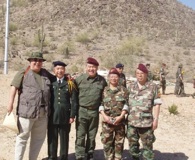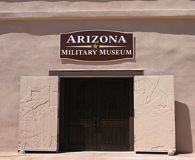HN: An event called Colonel Joe Abodeely’s Maricopa Arizona Base Camp is held on the first weekend in April every year. Explain to us what that is, and how you came to start it, please.
JA: It started long before I got involved. A medic from the 101st Airborne bought some property outside Maricopa, a small town between Phoenix and Tucson. It’s a rural area, out in the desert. “Doc,” as the medic was called, lived out there and had a kind of rally once a year in which he’d invite vets, mostly Vietnam vets and their families. They’d sit around telling war stories, drinking beer and swapping lies.
 After Doc passed away some others picked up the idea and moved the rally to a place a few miles from where I live now, to keep it going. They eventually lost the property in foreclosure. I called owners in California—this was when real estate was still cheap—and bought it, partly as an investment but also because I wanted to keep Base Camp going.
After Doc passed away some others picked up the idea and moved the rally to a place a few miles from where I live now, to keep it going. They eventually lost the property in foreclosure. I called owners in California—this was when real estate was still cheap—and bought it, partly as an investment but also because I wanted to keep Base Camp going.
There was already electricity at the place. We put in a Vietnam bar, built a guard tower, and a stage with electricity. A vet with a backhoe dug out a place at the base of the mountain and we put in a shooting range. Each year in April, we have Base Camp and invite veterans from all wars. We get some of the younger guys, but vets of any war are kind of parochial. The World War II vets didn’t really associate with us Vietnam guys, either.
HN: Looking at some pictures on the Base Camp Website, it appears you draw more than just American vets.
JA: I’m involved with the Vietnamese community here. We forget that we went to South Vietnam to help the Vietnamese people; I know that’s why I went in. We bring these Vietnamese to the Base Camp, and when we run the American flag up the pole we also run up the flag of South Vietnam. They can’t fly that Vietnam flag anywhere anymore. It doesn’t exist. They lost their country. In October, a Vietnamese Buddhist youth group comes out and camps here.
It’s just part of my way of giving back. I try to help people that our government left in the lurch.
HN: Tell us a bit about your work with the Arizona Military Museum. What is the origin and mission of that museum?
JA: We’re an official Army Museum of History and are certified by the Arizona Historical Society. We’re open every Saturday and Sunday from 1 to 4, September through May. The Arizona National Guard had set aside an old WPA adobe building, the largest adobe building still in continuous use in Arizona. We have a portion of it for the museum.
When I was in the Guard as a young officer, back in 1975, I went to a state Guard convention. Some senior officers were promoting the idea of having a historical society to collect memorabilia of the Arizona National Guard and Arizona military history. I joined and gave them some money, but didn’t think much more about it until I got a call in 1980 asking me to serve on the board. They screwed me—they made me president and they keep re-electing me.
I told the board—I was a major, and I had colonels and generals on that board—”We’re going to be a working board.” We tore out old bins, built this big room, brought in display cases. None of us get paid. We’re all volunteers.
 The museum’s displays start with the era of the Conquistadores, then the Spanish Colonial Period, the U.S. war with Mexico (1846–1848), and the California Column in the Civil War. During the Civil War, the governor got permission from the U.S. government to raise five companies to protect against Apaches. The 1st Arizona Regiment was made up mostly of Mexican and Maricopa and Pima Indian volunteers. It only lasted one year, and then the U.S. Army came out and fought the Indian Wars.
The museum’s displays start with the era of the Conquistadores, then the Spanish Colonial Period, the U.S. war with Mexico (1846–1848), and the California Column in the Civil War. During the Civil War, the governor got permission from the U.S. government to raise five companies to protect against Apaches. The 1st Arizona Regiment was made up mostly of Mexican and Maricopa and Pima Indian volunteers. It only lasted one year, and then the U.S. Army came out and fought the Indian Wars.
We cover the Indian Wars, the Spanish-American War, “On the Border” (Mexican Revolution of 1910)—my grandpa was in the 1st Cavalry during that border action. I have his helmet on one of the mannequins.
We may have one of largest Vietnam displays in country. There’s a Huey in the middle of it, and we’re working on a Khe Sanh diorama. When I started as president in 1980, Vietnam was as far as we could go. Since then we’ve added Desert Storm and other recent wars. I think Iraq and Afghanistan are going to make Vietnam look like the Quest for the Holy Grail, but I don’t put my opinions into those displays. You can damn the war but don’t damn the warrior.
(To view a slideshow of displays at the Arizona Military Museum, see the article by Peter Suciu on our partner site, ArmchairGeneral.com.)
HN: You have a Website and had a talk show and a TV program. What motivates you so strongly to share your information and opinions with the public?
JA: I have a high opinion of my opinion. (Laughs.) I’ve just been lucky to have a great deal of experience. When people talk about the military, saying we should do this, we should do that—well, I led troops in combat. I served as a JAG officer. I’m better equipped to talk about it than some professor or media personality.
[continued on next page]




